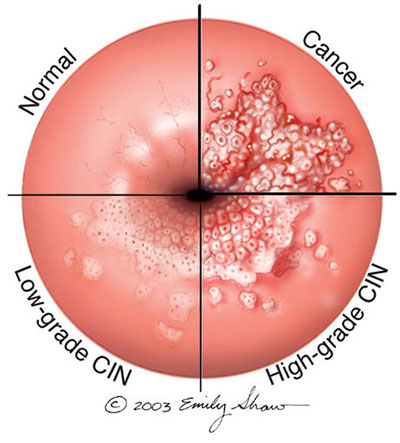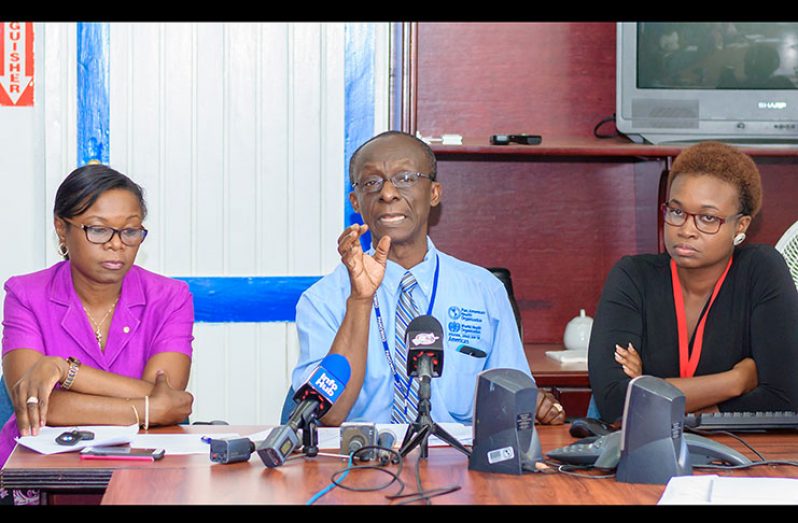AIMED at “saving this generation of girls from developing cervical cancer in the future,” the Public Health Ministry in collaboration with the Pan American Health Organisation/World Health Organisation (PAHO/WHO) will roll out a comprehensive Human Papilloma Virus (HPV) Vaccination Campaign next month, as it forges ahead with plans to immunise approximately 36,000 girls between the ages of nine and 13 across the country.

HPV is the most common sexually transmitted infection (STI), the Centers for Disease Control and Prevention states, explaining that the virus has the potential to develop genital warts and cancer, in particular cervical cancer, among women. In 71 countries across the world, health authorities are fighting back, utilising one of the most effective ways,that is, through the immunisation of young girls and boys using the HPV vaccine.
On Tuesday during a Media Brown Bag Meeting at the PAHO/WHO Country Office, its Country Representative, Dr. William Adu-Krow, said it is “high time” that Guyana re-initiates the widespread use of the HPV vaccine as he pointed to the facts surrounding cervical cancer, including its mortality rate.
“Data from WHO clearly identify cervical cancer as the second most common cancer in women of reproductive age group and if there is something that we can use to prevent it, then it is high time that we get on to using it,” Dr. Adu-Krow told the health journalists.
Further alluding to statistical reports produced by PAHO/WHO, the Country Representative pointed out that over 83,000 women were diagnosed with cervical cancer and almost 36,000 died from the disease in the Region of the Americas, in 2012.
“If this trend continues, the number of deaths in the Americas is projected to increase by 45% by the year 2030,” he warned. Added to that, Dr. Adu-Krow pointed out that cervical cancer mortality rates are three times higher in Latin America and the Caribbean than in North America. However, it must be noted that approximately 70 per cent of cancer cases could be avoided through HPV vaccination of adolescent girls.

Additionally, immunisation using HPV vaccines is more cost-effective than having to treat with cancer which damaging effects not only affect the individual, but the society as a whole.
Director of Maternal Child Health (MCH), Dr. Ertenisa Hamilton, who was also among the panelists who addressed the health journalists, explained that HPV has 150 strains with strains 16 and 18 known for causing cervical cancer. While it is a sexually transmitted disease, Dr. Hamilton noted that a person can become infected if he or she comes into direct contact with the virus from broken skin from any part of the body. Babies can also be infected during delivery if their mothers are infected.
“On a normal day, you can have the virus, but when there is that broken skin and it attacks the cells, which we call the mother cells,…what HPV does, it goes to that mother cell where everything starts, changes the DNA of that cell, so every other cell that would be formed from that multiplication process is going to be a cancerous cell,” she explained. Once the cancerous cell is developed, it spreads if not detected and treated at an early stage. However, it takes 15 to 20 years for cervical cancer to develop in women with normal immune systems. It can take only five to 10 years in women with weakened immune systems, such as those with untreated HIV infection.
Symptoms of cervical cancer tend to appear only after the cancer has reached an advanced stage, the MCH Director noted, while pointing out that symptoms include abnormal vaginal bleeding after sexual intercourse; back, leg or pelvic pain; fatigue, weight loss, loss of appetite; vaginal discomfort or odorous discharge; and swollen legs. Dr. Hamilton stated, however, that not all vaginal bleeding is linked to cervical cancer.
In Guyana, cervical cancer is the second most common cancer among women with the number of cases increasing. For the period 2003-2012, Dr. Hamilton said four per cent of the cancer was detected in stage one with 96 per cent of all other cancers detected at later stages.
Painting the grim reality of the situation here in Guyana, she pointed out that every year 27 out of every 100,000 women die from cervical cancer, even as she further alluded to the fact that Guyana has approximately 750, 000 people. The numbers, she lamented, are worrying.
“Two-thirds of all these cases was women under the age of 60. The age group that we found most at risk is 15-39,” she posited. While there is provision within the health care system for the screening and pap smear of women to detect cancer at an early stage, allowing for treatment, Dr. Hamilton was adamant that the most effective way of preventing cervical cancer is the HPV vaccine. Though HPV also attacks males, there is no diagnostic test in the country for them.
Turning her attention to the countrywide HPV Vaccination Campaign, which is set to commence on October 16, Dr. Hamilton said the HPV Vaccination is nothing new to Guyana, explaining that from 2012-2014, the HPV vaccine was introduced to the country with a donation of 21,600 doses. Vaccines were administered to girls 11-13 in Regions Three, Four, Five and Six. The campaign had started on a high note but fell for many reasons.
“One, the girls were mostly in grade six who received the vaccine, which means that some of them would have left their district and their region and so follow-up was difficult…Two, there was a very strong anti-vaccine campaign against the HPV vaccine that would have caused some of the fall out,” the MCH Director explained.
Back then, naysayers had argued that vaccinating the girls at such an early age to prevent a STI was providing them with a licence to have early sexual intercourse, but the health officials objected, noting that a similar argument was advanced when condoms were being given to adolescents, but research has found that there was no such spike linked to distribution of condoms or the use of the HPV vaccine.
This time around, she said the Public Health Ministry with support from PAHO/WHO is coming back with a “boom,” fully prepared with the requisite information.
During this campaign, the target group includes girls 9-13, and while the vaccine can be administered to persons 9 to 26, it is most effective between 9 and 16 years with a second dose required after the first six months,” Dr. Hamilton said. “If you are above 16, then three doses would be required,” she added. Some 36,000 girls are being targeted. Gardasil is the preferred vaccine used by the Public Health Ministry.
Though HPV is common among males as well, the MCH Director said the focus is on the vulnerable population, including girls and women. “If we do a very good job and achieve at least 95% of the girls within the age group, it means that the boys within that age group will be automatically protected,” she posited.
With the consent of their parents, girls will be immunised in the schools, at health centres across the country, and even at private health institutions at no cost. Outreaches are also expected to be conducted in remote areas to ensure the majority of girls within the targeted group are covered.
Dr. Hamilton said the Public Health Ministry is collaborating with the Education Ministry and private health institutions and practitioners to facilitate a successful campaign. Additionally, health personnel in the various regions at all levels are being trained and edified on the HPV vaccine.
The campaign is heavily funded by the Guyana Government with assistance from Global Alliance for Vaccines and Immunization (GAVI) and PAHO/WHO. Some 40, 000 doses of the vaccine have already been secured.





.jpg)








